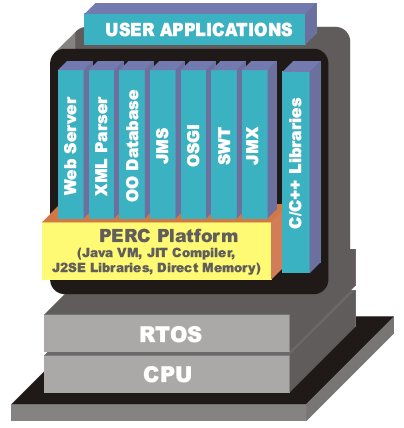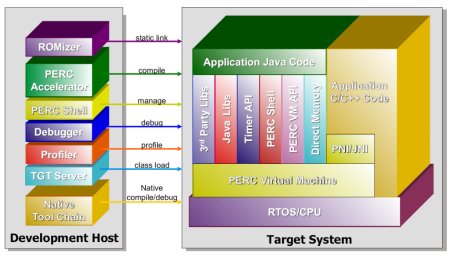JVM runtime rev’d with Wind River support
Apr 22, 2008 — by Eric Brown — from the LinuxDevices Archive — 9 viewsAonix upgraded its PERC Ultra Java runtime, a JVM (java virtual machine) aimed at embedded applications, and announced a design win with a Linux-based automotive diagnostic system from ETAS. PERC Ultra 5.1 improves performance and security, says Aonix, and adds support for real-time operating systems (RTOSes) including Wind River Linux.
The Java 5 compliant PERC Ultra is the most widely used real-time virtual machine, claims Aonix. It is commonly found in aerospace, defense, telecommunications, industrial automation, and robotics applications.
Newly supported RTOSes in version 5.1 include Wind River Linux, Sysgo's PikeOS, Mentor Graphics' Nucleus, and Green Hills' Integrity. Pre-existing support includes Wind River VxWorks, LynuxWorks LynxOS and LynxOS SE, MontaVista Mobilinux, and QNX Neutrino. The new version is said to offer plug-and-play compatibility with Wind River's Eclipse-based Workbench toolset.

PERC Ultra in typical embedded environment
New security enhancements include support for Java Secure Socket Extension (JSSE) and Java Cryptography Extension (JCE), says Aonix. Version 5.1 is also said to have more secure web services technologies, which have been upgraded to Java 5.0 compatibility. There is also improved support for Java 6 class files.
The performance improvements appear to apply primarily when using PERC Ultra with PERC Pico, Aonix's low-level hard real-time JVM. By optimizing the interface between the two products, the company claims that performance is twice as fast for integrated applications.
Previously PERC Ultra programmers were forced to use both Java Native Interface (JNI) and C to access low-level services of the underlying platform. This hindered performance, increased software maintenance costs, and compromised security, says Aonix. By integrating the high-level Ultra with the low-level Pico, problems associated with mixed-language embedded Java applications are said to disappear.

PERC Ultra architecture
(Click to enlarge)
Other existing touted features of PERC Ultra include:
- AOT (ahead of time) and JIT (just-in-time) compilation, in addition to interpreted execution mode
- Debugging available regardless of execution mode
- Remote debug support
- Deterministic garbage collection
- Standard graphics
- Support for either software floating point or Vector Floating Point (VFP) hardware in the i.MX31 processor
Stated Gary Cato, Aonix director of marketing, “With the continued need for portable, scalable applications, developers continue to look to higher level languages for their increased efficiency and modularity. The ability to totally eliminate C code, a known bottleneck and failure point for Java developers, will further propel adoption of Java in our target markets.”
Aonix announces automotive diagnostic win
Aonix also announced that PERC Ultra has been selected by ETAS Group, a subsidiary of Bosch, for a new line of an ARM/Linux-based automotive service diagnostic equipment. ETAS is said to provide diagnostic hardware and software to General Motors.
Using PERC Ultra, the ETAS systems can more easily enable automotive technicians to connect to onboard vehicle computers from multiple diagnostic devices on different platforms, including handheld devices, says Aonix. Integrated tightly with the diagnostic database, PERC Ultra is said to streamline the process of calling up specific information about replacement parts or even disassembly instructions from multiple types of devices.
Stated Cato, “Automotive is rapidly developing into one of our key focus markets. Java's productive, portable, and safe nature together with PERC's deterministic behavior and high reliability makes the automotive market an excellent fit for Aonix technology.”
Availability
PERC Ultra 5.1 appears to be available now, with more information available here. There was no information on the name, availability, or price of the new Linux-based ETAS automotive diagnostics system.
This article was originally published on LinuxDevices.com and has been donated to the open source community by QuinStreet Inc. Please visit LinuxToday.com for up-to-date news and articles about Linux and open source.